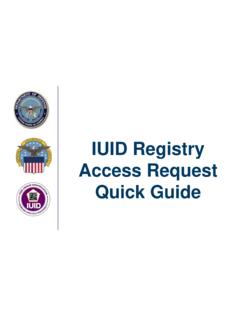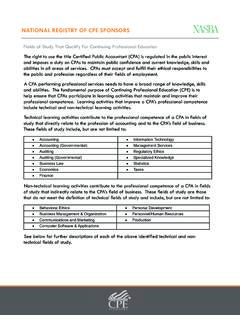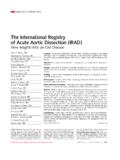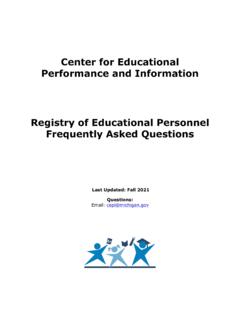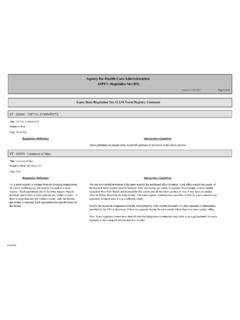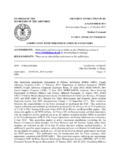Transcription of Guidelines for Developing an Information and Records ...
1 Guidelines for Developing an Information and Records management policy Guidelines for Developing an Information and Records management policy By Patrick Lambe and Marita Keenan This set of Guidelines is intended (i) to help an organisation understand the complementary relationships between knowledge management , Information management , and Records management ; (ii) to structure a policy development exercise so that policies affecting the flow and use of knowledge, Information and Records are mutually supportive and are aligned towards improving organisational effectiveness. The Guidelines focus in particular on Information and Records management as enablers of knowledge management , and do not capture all aspects of knowledge management needs. Knowledge management includes management practices in relation to both tangible Information artefacts such as documents and Records , as well as to more intangible knowledge assets such as experience, skills, and ways of doing things.
2 The intangible aspects of knowledge management are less directly influenced by policy work, which is designed to govern the management of tangible practices, processes and artefacts. However, the policy environment that relates to Information and Records has a strong impact on the ability of people to access and use their knowledge resources effectively, and to this extent, it has a high relevance to the capture, access and use dimensions of knowledge management . 1. Definitions Information and Information management We define Information as codified knowledge which is transferred and stored by means of documents, Records , publications, databases, tools, images, plans, sound/video recordings etc. In these Guidelines we use the term document to refer to any of the forms in which Information is carried. For the purposes of this paper we define Information management as the discipline of effective creation, collection, storage, access, use and disposal of Information assets.
3 Disposal does not necessarily mean destruction. It can mean transition to inactive or archival status. Archival status does not simply mean storing Information (or in the instance of data, moving it off-line). It means the designation of particular sets of Information as having enduring value either to the organisation or to wider society. As such managing the Information as an archive is based upon special Guidelines and policies which for public agencies are normally issued by government bodies, such as a national archive or a national library, in that jurisdiction. Information management is an important component of organisational effectiveness, which we define as: the ability to set and achieve organisational goals within target timeframes at a competitive cost and effort; 2006 Patrick Lambe and Marita Keenan 1 Guidelines for Developing an Information and Records management policy the ability to respond appropriately to emerging risks and opportunities in the environment.
4 Information management supports organisational effectiveness by providing: Consistency of Information - especially in customer facing processes Coordination between business units - especially for minimising errors Control of business activities - for ensuring timely and relevant decisions Compliance with laws, regulations, policies, standards and accreditation requirements - for ensuring accountability Cost Control - for avoiding re-work and redundancy of resource and effort When we assess the Information management policies, procedures and practices, we are also assessing whether they are able to capture and manage the characteristics of Information through its life cycle from creation, to use, to disposal. Records and Records management Records form a sub-set of Information , and because the discipline of Records management is driven by regulatory and accountability requirements, its practices are much more clearly defined.
5 Records are defined as follows: ISO 15489 Information created, received and maintained as evidence and Information by an organisation or person in pursuance of legal obligations or in the transaction of Records management refers to the professional practices associated with the management of Records through their life cycle, and is particularly relevant to the duties of dedicated registry or Records management staff. record keeping is a more general term that also includes the responsibilities of all employees in respect of Records creation, capture, storage and use. Records , like Information , have a clear lifecycle. When we assess the Records management policies, procedures and practices, just as in Information management we are also assessing whether they are able to capture and manage the characteristics of a record through its life cycle from creation, to use, to disposal. 1 It should be noted that transaction is taken to refer to internal and external transactions, operational transactions as well as strategic, planning, reporting, policy and procedural development and project activities.
6 2006 Patrick Lambe and Marita Keenan 2 Guidelines for Developing an Information and Records management policy 2. A Framework for Information and Records management policy Development A comprehensive framework for Information management policy building will need to cover six main areas, as illustrated in the diagram below. Description Information assets need to be summarised and accurately described if they are to be made visible to other work groups beyond their immediate work context. Titles, filenames and descriptions need to follow consistent formats and conventions, so that searchers can accurately judge the content of a document from its description. For electronic content, the Information describing the documents will be captured in metadata associated with each document, and this will help officers in locating relevant and useful Information via the content management system and search engine.
7 2006 Patrick Lambe and Marita Keenan 3 Guidelines for Developing an Information and Records management policy Subject categories also need to be consistently applied, and an organisation wide taxonomy usually forms a subset of the metadata fields to be assigned to a document. If insufficient metadata is assigned, or if it is inconsistently applied, then the assets, although available in the system, will effectively be invisible to users. For Records special metadata is also captured to sufficiently describe their format and processes which need to be applied to them to ensure their integrity is maintained over time should they need to be retained for a long period of time and managed and migrated across systems and software changes. Ownership The widespread and varied use of Information across the organisation means that no one group of staff can effectively control and manage all of the organisation s Information assets.
8 Responsibility for ensuring proper management of Information assets needs to be delegated to managers of operational units throughout the organisation. The principle of custodianship recognises that Information is owned by the organisation that creates and uses this Information in the course of business, but that there are designated persons throughout the organisation who need to ensure that particular sets of Information are adequately and appropriately managed. As such they are the custodians of those Information sets for which they are accountable. In addition, all officers have a responsibility for the proper creation, use and disposal of Information assets. The presence of a clear policy , identification of delegated responsibilities, and dissemination of good awareness and training on Information management policy will all help managers and their staff identify issues of intellectual property and copyright and exercise appropriate controls.
9 With delegated responsibilities the organisation ensures proper accountability for the management of Information , and compliance with external regulations and standards. Security All organisations need to protect certain categories of Information , whether for commercial reasons or in the public interest. Lack of proper management and control over the creation, transfer, storage and use of documents increases the risk of improper use of Information , for which the organisation may be held accountable. Protection of confidential and sensitive Information involves clear definition of custodial duties delegated to managers (see Ownership above), and clear, well-communicated Guidelines on how to classify the sensitivity of Information appropriately, and any special processes governing copying, transfer and use of those classes of Information . Where organisations also collect and use Information about members of the public in the course of doing business (such as booking systems, training provision, delivery of medical services), there is also the need to protect Information based on privacy grounds, for ethical and legal reasons.
10 2006 Patrick Lambe and Marita Keenan 4 Guidelines for Developing an Information and Records management policy Compliance Both commercial and public sector organisations are under statutory obligations to keep their business Records in an accessible form for minimum periods of time. Public sector organisations may also have legal requirements to maintain Records and also to ensure proper management of those Records designated as candidates for national archives. In the event of litigation, contractual disputes, criminal investigations or official inquiries, the organisation may be obliged by the authorities to produce evidence of the activities and decisions at dispute or under inquiry. It must also be able to produce documentation as evidence of the related business activities and of compliance with government policies and regulations, such as procurement Guidelines . If the organisation holds accreditation according to specific standards such as ISO certification, then it must also be able to manage its Information and Records to demonstrate continuing adherence to the accreditation standard.




